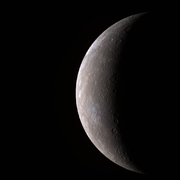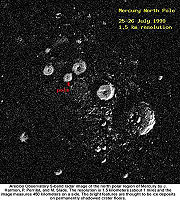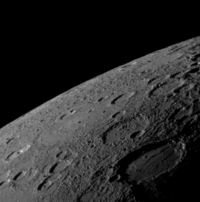
Colonization of Mercury
Encyclopedia

Mercury (planet)
Mercury is the innermost and smallest planet in the Solar System, orbiting the Sun once every 87.969 Earth days. The orbit of Mercury has the highest eccentricity of all the Solar System planets, and it has the smallest axial tilt. It completes three rotations about its axis for every two orbits...
has been suggested as one possible target for space colonization
Space colonization
Space colonization is the concept of permanent human habitation outside of Earth. Although hypothetical at the present time, there are many proposals and speculations about the first space colony...
of the inner Solar System
Solar System
The Solar System consists of the Sun and the astronomical objects gravitationally bound in orbit around it, all of which formed from the collapse of a giant molecular cloud approximately 4.6 billion years ago. The vast majority of the system's mass is in the Sun...
, along with Mars
Colonization of Mars
The colonization of Mars by humans is the focus of speculation and serious study because the surface conditions and availability of water on Mars make it arguably the most hospitable planet in the solar system other than Earth...
, Venus
Colonization of Venus
The colonization of Venus has been a subject of much speculation and many works of science fiction since before the dawn of spaceflight, and is still much discussed...
, the Moon
Colonization of the Moon
The colonization of the Moon is the proposed establishment of permanent human communities on the Moon. Advocates of space exploration have seen settlement of the Moon as a logical step in the expansion of humanity beyond the Earth. Recent indication that water might be present in noteworthy...
and the asteroid
Asteroid
Asteroids are a class of small Solar System bodies in orbit around the Sun. They have also been called planetoids, especially the larger ones...
belt. Permanent colonies would almost certainly be restricted to the polar regions due to the extreme daytime temperatures elsewhere on the planet. Excursions to the other parts of the planet would be feasible with appropriate measures, particularly along the very slowly moving terminator
Terminator (solar)
A terminator, twilight zone or "grey line" is a moving line that separates the illuminated day side and the dark night side of a planetary body...
, which would approximate polar conditions.
Similarity to the Moon
Like the Earth's MoonMoon
The Moon is Earth's only known natural satellite,There are a number of near-Earth asteroids including 3753 Cruithne that are co-orbital with Earth: their orbits bring them close to Earth for periods of time but then alter in the long term . These are quasi-satellites and not true moons. For more...
, Mercury does not have any significant atmosphere. It is close to the Sun and performs slow rotations with a very small tilt of its axis. Because of this similarity any colonization of Mercury might be performed with the same general technology, approach and equipment as a colonization of the Moon
Colonization of the Moon
The colonization of the Moon is the proposed establishment of permanent human communities on the Moon. Advocates of space exploration have seen settlement of the Moon as a logical step in the expansion of humanity beyond the Earth. Recent indication that water might be present in noteworthy...
. Bruce Murray
Bruce C. Murray
Bruce C. Murray was born November 30, 1931 in New York, NY. He is a professor emeritus of planetary science and geology at Caltech and was Director of the Jet Propulsion Laboratory from April 1, 1976 to June 30, 1982.He received his Ph.D...
referred to Mercury as "A Mini-Earth in Moon's Clothing". Unlike the Moon however, Mercury has the additional advantage of a magnetic field protecting it from cosmic rays and solar storms, and a larger surface gravity of about 0.38 g, nearly equal to that of Mars
Mars
Mars is the fourth planet from the Sun in the Solar System. The planet is named after the Roman god of war, Mars. It is often described as the "Red Planet", as the iron oxide prevalent on its surface gives it a reddish appearance...
.

Ice in polar craters
Due primarily to its distance from the Sun, the surface of Mercury can reach 700 K (427 °C, 800 °F), hot enough to melt leadLead
Lead is a main-group element in the carbon group with the symbol Pb and atomic number 82. Lead is a soft, malleable poor metal. It is also counted as one of the heavy metals. Metallic lead has a bluish-white color after being freshly cut, but it soon tarnishes to a dull grayish color when exposed...
. However, temperatures at the polar regions are much colder and there may even be deposits of ice inside permanently shaded craters. The polar areas do not experience the extreme daily variation in temperature seen on more equatorial areas of Mercury's surface.
Solar energy
Being the closest planet to the Sun, Mercury has vast amounts of solar power available. Its solar constantSolar constant
The solar constant, a measure of flux density, is the amount of incoming solar electromagnetic radiation per unit area that would be incident on a plane perpendicular to the rays, at a distance of one astronomical unit...
is 9.13 kW/m², 6.5 times that of Earth
Earth
Earth is the third planet from the Sun, and the densest and fifth-largest of the eight planets in the Solar System. It is also the largest of the Solar System's four terrestrial planets...
or the Moon. Because the tilt of its axis of rotation relative to its orbit is so low, approximately 0.01 degrees, there is also the possibility of so-called peaks of eternal light, similar to those of the Moon—high points located at the poles of the planet that are continuously radiated by the Sun. Even if they do not exist, it is possible that they could be constructed artificially.
In 1986, C.R. Pellegrino
Charles R. Pellegrino
Charles R. Pellegrino is the controversial author of several books relating to science and archaeology, including Return to Sodom and Gomorrah, Ghosts of the Titanic, Unearthing Atlantis and Ghosts of Vesuvius....
and J.R. Powell proposed covering Mercury with solar power farms, and transferring some of the resulting energy into a form useful for propulsion for interstellar travel
Interstellar travel
Interstellar space travel is manned or unmanned travel between stars. The concept of interstellar travel in starships is a staple of science fiction. Interstellar travel is much more difficult than interplanetary travel. Intergalactic travel, or travel between different galaxies, is even more...
.
Valuable resources
There are predictions that Mercury's soil may contain large amounts of helium-3Helium-3
Helium-3 is a light, non-radioactive isotope of helium with two protons and one neutron. It is rare on Earth, and is sought for use in nuclear fusion research...
, which could become an important source of clean nuclear fusion energy on Earth and a driver for the future economy of the Solar System. However, Mercury's magnetic field could have prevented helium-3
Helium-3
Helium-3 is a light, non-radioactive isotope of helium with two protons and one neutron. It is rare on Earth, and is sought for use in nuclear fusion research...
from reaching the surface.
Mercury is also theorized to have a crust rich in iron
Iron
Iron is a chemical element with the symbol Fe and atomic number 26. It is a metal in the first transition series. It is the most common element forming the planet Earth as a whole, forming much of Earth's outer and inner core. It is the fourth most common element in the Earth's crust...
and magnesium
Magnesium
Magnesium is a chemical element with the symbol Mg, atomic number 12, and common oxidation number +2. It is an alkaline earth metal and the eighth most abundant element in the Earth's crust and ninth in the known universe as a whole...
silicates, with the highest concentrations of many valuable minerals of any surface in the Solar System, in highly concentrated ores.
Geologist Stephen Gillett
Stephen Gillett
Stephen Gillett is a technology and business leader currently serving as Chief Information Officer, Executive Vice President and General Manager of Digital Ventures at Starbucks Coffee Company in Seattle, WA. Gillett was hired by Howard Schultz as part of the transformation leadership team in 2008....
has suggested this will make Mercury an ideal place to build solar sails, which could launch as folded up "chunks" by mass driver
Mass driver
A mass driver or electromagnetic catapult is a proposed method of non-rocket spacelaunch which would use a linear motor to accelerate and catapult payloads up to high speeds. All existing and contemplated mass drivers use coils of wire energized by electricity to make electromagnets. Sequential...
from Mercury's surface. Once in space the solar sails would deploy. Since Mercury's solar constant
Solar constant
The solar constant, a measure of flux density, is the amount of incoming solar electromagnetic radiation per unit area that would be incident on a plane perpendicular to the rays, at a distance of one astronomical unit...
is 6.5 times higher than Earth's, energy for the mass driver should be easy to come by, and solar sails near Mercury would have 6.5 times the thrust they do near Earth. This could make Mercury an ideal place to acquire materials useful in building hardware to send to (and terraform) Venus.
Considerable gravity
Mercury is bigger than the Moon, with a diameter of 4879 km versus 3476 km, and has a higher density due to its large iron core. As a result, gravity on the surface of Mercury is 0.377 gG-force
The g-force associated with an object is its acceleration relative to free-fall. This acceleration experienced by an object is due to the vector sum of non-gravitational forces acting on an object free to move. The accelerations that are not produced by gravity are termed proper accelerations, and...
, more than twice that of the Moon (0.1654 g) and very close to the surface gravity on Mars. Since there is evidence of human health problems associated with extended exposure to low gravity, from this point of view, Mercury might be more attractive for long-term human habitation than the Moon.
Difficulties

Mercury is also deep in the Sun's gravitational potential well
Potential well
A potential well is the region surrounding a local minimum of potential energy. Energy captured in a potential well is unable to convert to another type of energy because it is captured in the local minimum of a potential well...
, requiring a larger velocity change (delta V) to travel to and from Mercury than is needed for other planets, although, in the past, gravity assist orbits using Venus
Venus
Venus is the second planet from the Sun, orbiting it every 224.7 Earth days. The planet is named after Venus, the Roman goddess of love and beauty. After the Moon, it is the brightest natural object in the night sky, reaching an apparent magnitude of −4.6, bright enough to cast shadows...
have been used to reach Mercury. However, entering orbit
Orbit
In physics, an orbit is the gravitationally curved path of an object around a point in space, for example the orbit of a planet around the center of a star system, such as the Solar System...
around Mercury and landing on the surface would take 6 years with current propulsion methods. Solar sails and mass drivers may assist in transportation in the future, but are not viable options at present.

